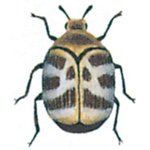They do not – just like clothes moth – leave traces of fibre strands or visible faeces, so it may initially seem a bit puzzling.
The adult museum beetles look like small ladybugs, but they do not have their clear, shiny colours. They have beautiful, dull, yellow, brown and grey colours caused by small coloured scales, distributed in a pattern across the elytra. this is the same principle that gives butterflies their colours.
It is especially in early spring, you see the adult beetles. They come out and if they have overwintered in a house, they will seek towards light, they go out into the wild to find food, which consists of nectar and pollen. One can then find them in abundance on plants as spirea and wild carrots. They mate in flowers and then the females find a place to lay their eggs. It has to be a place where the larvae are able to find food. The larvae are specialists in regards to their own diet, they feed on the very last dry remains of dead animals where the other scavengers give up. That is cartilage, tendons, hair and feathers. It is useful work to get this dead animal material into the “circle of life” again, but it is this exact ability to digest wool and feathers that brings them into conflict with us.
Favourable conditions are found in old birds’ nests where there are feather debris, and maybe a dead baby bird. A dry carcass, perhaps a dead mouse, in an attic is also suitable and they also lay eggs directly on woolen textiles
The larvae grow up to 5 mm. They look like tiny armadillos with a coat of brown, spiky hair. The larvae are sometimes called wooly bears, because they may actually look like adorable little bears. In the rear end, the museum beetle larvae have some characteristic tufts of long hair, which ends in a small arrowhead-like spike, and is therefore called arrow-hair. If you tease a museum beetle larva it is possible to see how the arrow-hairs, and there is no doubt that they serve as a defensive weapon. If the larva is under attack, it faces the rear end against the attacker, raises the hairs and turn them from side to side. They break easily and when predators get these hairs in the mouth or on the body, it has to clean it off, and the museum beetle larvae might escape.
Museum beetle larvae are usually a year to develop, but when food is scarce, it can take much longer. They can live long without food, they put their metabolism down and consume the nutrients they have stored. A unique feature is that they can grow downwards.
Like other insects, the larvae change skin several times during their growth, and they are generally larger at each moult. If they do not eat, they can grow smaller, and it has been shown that they also grow physiologically younger. It is interesting, for they have apparently managed to turn the usually inevitable process is it to grow older.
Museum beetles are very common and active animals, and a total prevention is not possible. It it possible to have the beetles and not see any damage from them. But if they appear in large numbers, and if there are be holes in wool goods, one must of course take action.
At first you must find out where they come from. As mentioned, birds’ nests under the roof is an obvious hotbed, but felt pads, forgotten wool goods in inaccessible places are also options.
The extermination must aim to eliminate the infestation, vacuum the surroundings thoroughly and if necessary treat with an approved insecticide. Wool garments are washed in the washing machine or placed 2-3 days in a freezer. If clean wool goods are kept in sealed bags they are protected against new attacks.
Museum beetles are feared guests on many types of museums. They can destroy textiles and destroy an insect collection completely.





